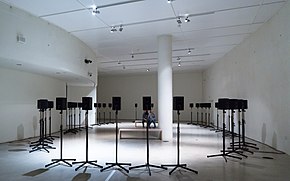
Back فن صوتي Arabic Art sonor Catalan Klangkunst German Ηχητική τέχνη Greek Sonarto Esperanto Arte sonoro Spanish Helikunst Estonian هنر صوتی Persian Äänitaide Finnish Art sonore French
Sound art is an artistic activity in which sound is utilized as a primary medium or material.[1] Like many genres of contemporary art, sound art may be interdisciplinary in nature, or be used in hybrid forms.[2] According to Brandon LaBelle, sound art as a practice "harnesses, describes, analyzes, performs, and interrogates the condition of sound and the process by which it operates."[3]

In Western art, early examples include the Futurist Luigi Russolo's Intonarumori noise intoners (1913), and subsequent experiments by dadaists, surrealists, the Situationist International, and in Fluxus events and other Happenings. Because of the diversity of sound art, there is often debate about whether sound art falls within the domains of visual art or experimental music, or both.[4] Other artistic lineages from which sound art emerges are conceptual art, minimalism, site-specific art, sound poetry, electro-acoustic music, spoken word, avant-garde poetry, sound scenography,[5] and experimental theatre.[6]
- ^ [1] 11 Essential Sound Artworks, from Reviled Noise Orchestras to Protest-Minded Installations by Tessa Solomon October 8, 2020 Artnews
- ^ Szendy, Peter. Listen: A History of Our Ears, Fordham University Press, pp. 5-8
- ^ LaBelle, Brandon (2006). Background Noise: Perspectives on Sound Art (London and New York: Continuum), p. ix. ISBN 9780826418449
- ^ Goldsmith, Kenneth. Duchamp Is My Lawyer: The Polemics, Pragmatics, and Poetics of UbuWeb, Columbia University Press, New York, p. 125.
- ^ Brückner, Atelier (2010). Scenography / Szenografie - Making spaces talk / Narrative Räume. Stuttgart: avedition. p. 209.
- ^ Kenneth Goldsmith, Duchamp Is My Lawyer: The Polemics, Pragmatics, and Poetics of UbuWeb, Columbia University Press, New York, p. 136.